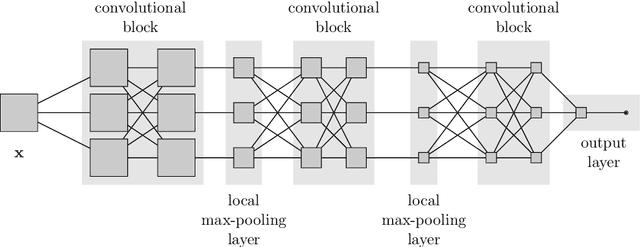Benjamin Walter
Analysis of the rate of convergence of an over-parametrized convolutional neural network image classifier learned by gradient descent
May 13, 2024Abstract:Image classification based on over-parametrized convolutional neural networks with a global average-pooling layer is considered. The weights of the network are learned by gradient descent. A bound on the rate of convergence of the difference between the misclassification risk of the newly introduced convolutional neural network estimate and the minimal possible value is derived.
Analysis of convolutional neural network image classifiers in a rotationally symmetric model
May 11, 2022



Abstract:Convolutional neural network image classifiers are defined and the rate of convergence of the misclassification risk of the estimates towards the optimal misclassification risk is analyzed. Here we consider images as random variables with values in some functional space, where we only observe discrete samples as function values on some finite grid. Under suitable structural and smoothness assumptions on the functional a posteriori probability, which includes some kind of symmetry against rotation of subparts of the input image, it is shown that least squares plug-in classifiers based on convolutional neural networks are able to circumvent the curse of dimensionality in binary image classification if we neglect a resolution-dependent error term. The finite sample size behavior of the classifier is analyzed by applying it to simulated and real data.
Analysis of convolutional neural network image classifiers in a hierarchical max-pooling model with additional local pooling
May 31, 2021



Abstract:Image classification is considered, and a hierarchical max-pooling model with additional local pooling is introduced. Here the additional local pooling enables the hierachical model to combine parts of the image which have a variable relative distance towards each other. Various convolutional neural network image classifiers are introduced and compared in view of their rate of convergence. The finite sample size performance of the estimates is analyzed by applying them to simulated and real data.
Robust Image Descriptors for Real-Time Inter-Examination Retargeting in Gastrointestinal Endoscopy
Oct 30, 2016



Abstract:For early diagnosis of malignancies in the gastrointestinal tract, surveillance endoscopy is increasingly used to monitor abnormal tissue changes in serial examinations of the same patient. Despite successes with optical biopsy for in vivo and in situ tissue characterisation, biopsy retargeting for serial examinations is challenging because tissue may change in appearance between examinations. In this paper, we propose an inter-examination retargeting framework for optical biopsy, based on an image descriptor designed for matching between endoscopic scenes over significant time intervals. Each scene is described by a hierarchy of regional intensity comparisons at various scales, offering tolerance to long-term change in tissue appearance whilst remaining discriminative. Binary coding is then used to compress the descriptor via a novel random forests approach, providing fast comparisons in Hamming space and real-time retargeting. Extensive validation conducted on 13 in vivo gastrointestinal videos, collected from six patients, show that our approach outperforms state-of-the-art methods.
 Add to Chrome
Add to Chrome Add to Firefox
Add to Firefox Add to Edge
Add to Edge